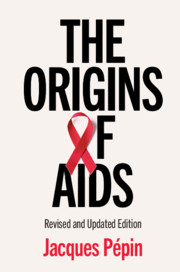Book contents
- The Origins of AIDS
- The Origins of AIDS
- Copyright page
- Dedication
- Contents
- Figures
- Maps
- Acknowledgements
- Note on Toponymy
- Abbreviations
- Introduction
- Chapter 1 Out of Africa
- Chapter 2 The Source
- Chapter 3 The Timing
- Chapter 4 The Cut Hunter
- Chapter 5 The Scramble for Central Africa
- Chapter 6 Tropical Boom Towns
- Chapter 7 The Oldest Profession
- Chapter 8 Injections and the Transmission of Viruses
- Chapter 9 The Legacies of French Colonial Medicine
- Chapter 10 The Legacies of Belgian Tropical Medicine
- Chapter 11 The Other Human Immunodeficiency Viruses
- Chapter 12 From the Congo to the Caribbean
- Chapter 13 The Blood Trade
- Chapter 14 A Long Journey
- Chapter 15 Globalisation
- Chapter 16 A False Villain, a Genuine Hero
- Chapter 17 Epilogue
- References
- Index
Chapter 12 - From the Congo to the Caribbean
Published online by Cambridge University Press: 05 January 2021
- The Origins of AIDS
- The Origins of AIDS
- Copyright page
- Dedication
- Contents
- Figures
- Maps
- Acknowledgements
- Note on Toponymy
- Abbreviations
- Introduction
- Chapter 1 Out of Africa
- Chapter 2 The Source
- Chapter 3 The Timing
- Chapter 4 The Cut Hunter
- Chapter 5 The Scramble for Central Africa
- Chapter 6 Tropical Boom Towns
- Chapter 7 The Oldest Profession
- Chapter 8 Injections and the Transmission of Viruses
- Chapter 9 The Legacies of French Colonial Medicine
- Chapter 10 The Legacies of Belgian Tropical Medicine
- Chapter 11 The Other Human Immunodeficiency Viruses
- Chapter 12 From the Congo to the Caribbean
- Chapter 13 The Blood Trade
- Chapter 14 A Long Journey
- Chapter 15 Globalisation
- Chapter 16 A False Villain, a Genuine Hero
- Chapter 17 Epilogue
- References
- Index
Summary
Chapter 12 starts with a review of the chaotic decolonisation process in the former Belgian Congo through a biography of one of its most pre-eminent protagonists, Patrice Lumumba. The instability of the newly independent country led to the massive pauperisation of its population, triggering (see ) not just profound changes in the pattern of prostitution in the capital, but also the brutal collapse of its health and education systems. Belgian doctors and teachers fled the young country and were replaced by a large number (~4,500) of Haitian technical assistants. One of them, and probably only one, got infected with HIV and brought it back to the Caribbean island around 1967. The chapter recounts how HIV was progressively recognised as being prevalent among Haitians, first in the USA and then in Haiti itself. After the Cuban revolution, sexual tourism developed in Haiti, and in the 1970s and early 1980s many American gay men visited the island for a holiday of sun and (paid) sex. This was the most likely route for the virus’ quick re-exportation to the USA, where it landed in New York City in 1971.
- Type
- Chapter
- Information
- The Origins of AIDS , pp. 254 - 274Publisher: Cambridge University PressPrint publication year: 2021

